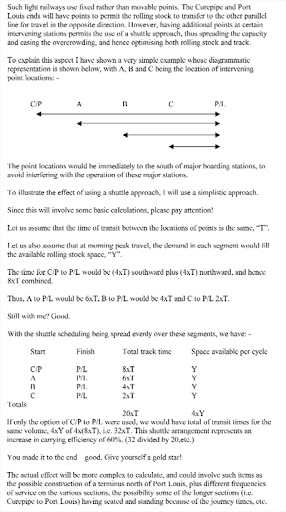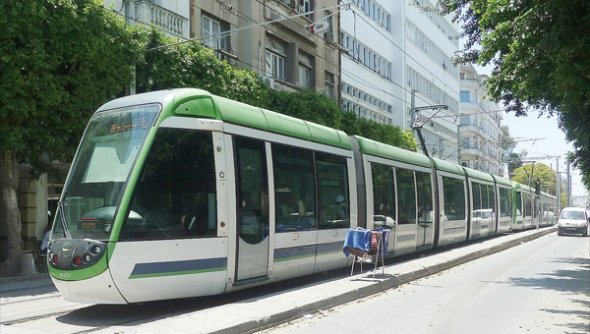These are the main proposals consultant Michael J. Forbes, in a document entitled "Alternative Mauritian Light Transport System", submitted to the Mauritian government through the introduction of light rail.
Michael J. Forbes is categorical. The introduction of light rail will not magical effect on the problem of traffic congestion. Without proper planning, it can even occassionner other problems. As congestion on certain stations and improper operation.
The biggest challenge, he says, is to find a balance between the demand during the peak hours and off-peak hours. A policy to meet the high demand during peak hours consequence will be to under-utilization of the subway during peak hours. Conversely, directing capacity on demand during peak hours, congestion in the metro light is inevitable during peak hours. "THUS We have the dilemma: do we Have Sufficient capacity to handle peak and hence Demands Have a poor use of the capacity at off-peak times, or do we Have Sufficient capacity to handle the off-peak traffic, resulting and in overcrowding at peak demand times forcing many to resort to other means clustering of transport? "Asks the consultant.
The lack of balance between these two causes, according to Michael J. Forbes, inconvenience for passengers. He cites the case of the Japanese capital. In Tokyo, at peak times, passengers traveling like sardines in a box. They are pressed into the cabin by station attendants. "In the instance of the Tokyo transportation system, uniformed staffs, complete with white gloves, cram the maximum number of passengers on the rolling stock," is it out. The crowding of passengers, says it is a reality even in Europe: "Those of you That have 'enjoyed' the London Underground Journey Between Euston and Victoria at peak travel périodes will be ble to confirm the level of crunch and discomfort experienced. '
To avoid a similar situation in Mauritius, Michael J. Forbes recommends the formula shuttle between stations during peak hours and standing room between neighboring stations. "In Considering the proposal for a light rail system, I have Looked at it from a demand based approach Rather Than a resource approach," said he to Challenge-Plus.
Rush Hour - The imperative shuttles
For the consultant, a shuttle system is required because the morning rush hour, passengers at stations closest to Port Louis will not have seats. The metro will descend Curepipe full as an egg. "One important aspect is how this portion of the system will operate. For instance, in the morning, the passengers boarding at Curepipe, Floreal, Vacoas and Phoenix for travel to Port Louis, Could take much of the available capacity. Any resulting crowding Could not make it to For Those nearer to Port Louis board, "he says in his paper.
This problem can be solved, he said, with shuttles to Provide standing room only between Port Louis and close stations. "The morning peak period will result in total Increasing demand year as the rail units approach Port Louis. Having the shuttle by shorter legs with all standing arrangement and with a Higher frequency, much of this demand will be handled. However, it is doubtful That Those traveling from, say, Would accept Curepipe Having to stand for the period of travel. Malthus at the more southerly stations, the arrangement with seats down Would Be. As the rail unit approches Port Louis, any, additional passengers Would have to stand, "said he to Challenge-Plus.
In a diagram for explanation, Michael J. Forbes had five main stations on the path Curepipe-Port Louis. Between these two cities, there are three intermediate stations - A, B and C. Based on its recommendations, the morning rush hour, a vehicle descends from Curepipe and another station A. Shuttle and station B and C. (See diagram below) According to his calculations, the shuttle system will increase capacity by 60%.
Shuttles and standees will, according to his estimates, optimize capacity: "The combination of Utilising a high-density non-seated configuration shuttle services and at peak times will offer optimum capacity. At other times, a more relaxing travel arrangement will be available. '
Better, it encrypts the optimization of capacity two and a half times, "If the seats are in aluminum - better than upholstered As They are more hygienic and Easier To keep clean - and can be hinged and locked up, then this means clustering by the carrying Increased capacity is much. A conservative estimate of the carrying capacity Increased Would Be of the order of two and half times for all That seated. '
The metro project started in 2013
The government is determined to embark on the light rail. He plans to start this project in partnership with the private sector, under the concept of Public Private Partnership (PPP), next year. The cost of Rs 25 billion is way cool his ardor. This project is delayed for 30 years back on track since Prime Minister Navin Ramgoolam visited Singapore in September 2010. And since the government signed an agreement with the Singapore Corporation of Enterprise (SCE) for the implementation of a similar system in Mauritius.
Accordance with the national transportation strategy and program of road congestion, the light rail project will serve as a first time, the journey Curepipe-Port Louis as an alternative mode of public transport. The project will be implemented in collaboration with the Singapore government. The Singapore government will support, through the Singapore Corporation Enterprise for the following services: (i) the determination of a feasible alignment for all LRT corridor between Curepipe and Port Louis (ii) economic analysis, including including financial structuring for the project, (iii) the development of the concept and preliminary design stage can generate market interest in the project from relevant parties and to initiate calls to offers encrypted, and (iv) a thorough assessment of a possible extension to the north and south of the corridor Curepipe-Port Louis.
Everything indicates that the Light Rail Transit System between Port Louis and Curepipe include a network of 25 km of track and 13 stations, served by 'feeder nozzles'. The duration of a trip will
32 minutes, and trains will be air conditioned.
Specifications
Network: 24.9 km
Number of stations: 13
Maximum speed: 75 km / h
Downtime stations: 20 seconds
Journey time: 32 minutes
Round trip: 70 minutes
Frequency metros: 12 per hour
Rowing capacity: 250 passengers (500 in metro)
Length of train: 30 meters
Width of a string: 2.65 meters
Spaces allocated to seats: 25 - 30%
Passengers at peak hours: 6000
per hour
Passengers per day: 93,000
Number of metro stations: 14 (two oars each)
Peak - Transport passengers - Goods
The point of view of profitability, Michael J. Forbes suggested that the metro transports passengers and cargo simultaneously during peak hours. Also transporting goods, traffic congestion will be eased further: "Its use for commercial transportation via Purposes operations for multi-client warehouses, road transport vehicles and feeder roads into / out of the rail spine, will lead to major operations in Efficiencies and Reduced congestion. '
In this context, he proposed that the route be extended north to serve the industrial area of Riche-Terre: "A similar conditions apply for Would Any extension north of Port-Louis and rail units Those approaching Port Louis. Any consideration of year extension to a northern terminus shoulds take into account some companies That Have Moved to Riche Terre. In addition, there are warehouses, a cold store, depots, and factories in this region. '
To transport goods, Michael J. Forbes argues that requires specifications for light rail Mauritius as a low floor and flat: "In off-peak périodes, and even with all year seated arrangement, it is Likely That will be some spare capacity available. Properly Organised and with low level and flat floors with portable dock Levelers, this capacity can be used for commercial transportation of goods some, using the rail system as a spine in a hybrid multi-modal arrangement, linking up with road transport. '
In addition, he suggested that the bogie is used instead of the axle to the floor is flat "Together with the flat floor design, the drive to the rails must be by bogie units Rather Than axles. Axle driven units and a flat floor, the floor level results in much Being Higher Than The general ground level. Took some pictures I recently of the system in Manchester, UK. Those of you who Have Worked / lived in this area will know que les rolling stock of HAS level access some 900mm from ground level. Because this is the axle drive shafts Have units similar to conventional trains. '
 m
m



